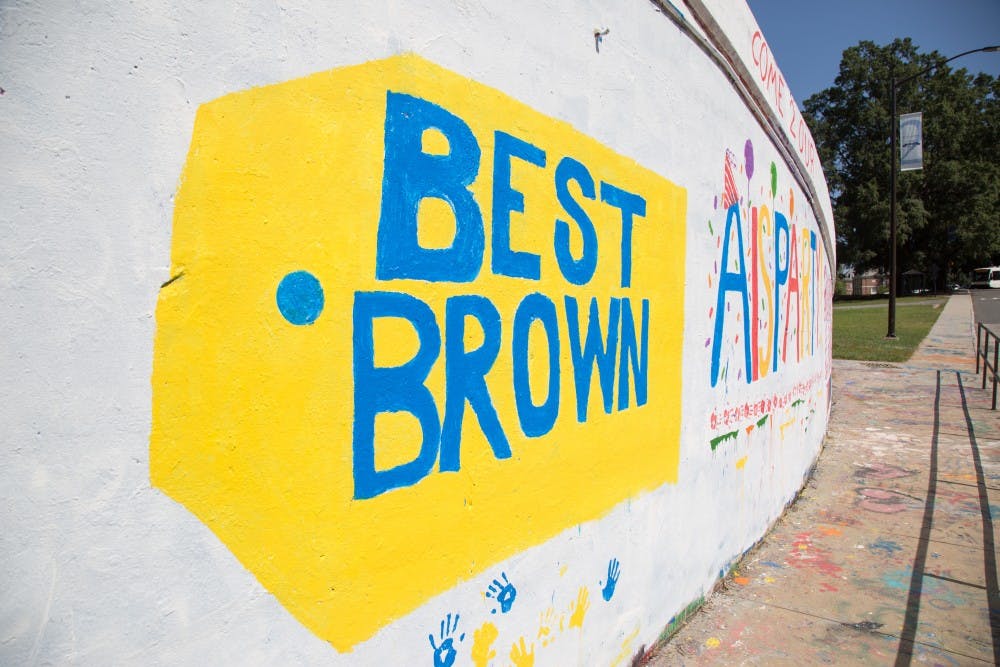For a few brief seconds on every trip between East and West campuses, the graffiti wall under the Main Street bridge offers riders and passersby a flash of color.
Those who pay attention as the bus passes find a mix of messages. The wall is a platform for politics, a canvass for creativity, a stage for frats to wrestle for relevancy and a good place to write bad words.
At any moment, it tells hundreds of stories. But what is the wall’s story?
North Carolina Department of Transportation records say the Main Street bridge was built in 1950. However, they announced bridge renovations in 2004, then pushed them back 5 years. Renovation finally started in 2013, seven years after the bridge was deemed “functionally obsolete.”
The bridges that cross that chunk of Campus Drive include the wide Main Street bridge, a train trestle and the Pettigrew Street bridge.
William King, Duke University archivist emeritus, said in a 2004 Durham Herald-Sun article that “the bridge had to have been built” in the 1920s when East Campus was redesigned. He further challenges the wall’s history in the article, claiming to have received a letter that indicates that graffiti donned the bridge around 1940.
The earliest known example of bridge painting is a photo from the 1963 Chanticleer.
The type of art and messages adorning the bridge don’t seem to have changed much through time. A 1994 News & Observer article offers a snapshot of the wall, noting that names, “sorority and fraternity letters,” “pi to more than a dozen digits, along with a graphic representation of a warped plane that is the basis for an alternative form of geometry” and “a minimalist painting of a droopy-lidded dude smoking something” stuck out at the time. In that article, an interviewed student wasn’t impressed by the bridge.
“I don’t know… maybe it just represents the self-absorbed Duke students and their egocentric preoccupation with writing their names?” then-junior Ken Klapper said.
The official nature of the free expression area—Duke condones the painting so long as it stays off of the bridge overpass, sidewalk, street, and railing—and the subject matter put on the wall have led to some criticism through the years.
“If graffiti is a lion of the urban jungle, our East Campus Bridge graffiti is a domesticated house cat,” Chronicle columnist James Tager, then a junior, wrote in 2008.
But the bridge has seen quite a bit of controversy. An examination of The Chronicle’s online database revealed a number of incidents from the 1990s onward.
In 1990, the Duke Gay and Lesbian Association messages in support of Coming Out Week were painted over with the words “No thanks, AIDS kills.” Around that time, “the Kappa Alpha fraternity decorated the bridge with a huge Confederate Flag.” In 1994, homophobic slurs were written on the wall.
In response, the words “We’re still everywhere” was painted over them. Todd Presner, then DLGA Chair, criticized the University for whitewashing the slurs in a Chronicle column, arguing that the censorship set a dangerous precedent. Three years later, Facilities painted over the DLGA’s messages in support of Coming Out Week.
The whitewashing didn’t seem to condemn all controversial messaging, however. In 2009, a drawing of male genitalia with the words “make me a sandwich” written on it was left up, leading to complaints.
More recently, in 2016, racial, anti-semitic, and homophobic slurs were discovered on the wall by a group gathering to paint for an NAACP, Mi Gente and Asian Student Association event.
Although sometimes divisive, the wall has the power to bring people together. Durham based artist Jonathan Massullo, whose large, vivid murals can be seen on the wall, thinks the space is important.
“For local artists who work in spray paint or murals I can’t express enough the significance of walls like the East Campus wall… The response is always overwhelmingly positive, the range of people who stop to look or chat is incredible, all ages and walks of life,” Massullo said.
“Many of those who seem truly interested in the work are those who most likely would have had little exposure to artwork of that nature, apart from amateurish back-alley tags or pieces on passing freights,” Massullo said. “It’s likely many of those people probably viewed any sort of street art or graffiti as a public nuisance or vandalism, and hopefully now they have a broader horizon. If I can help open anyone’s mind and accept sprayart as legitimate I’d be happy.”
With some controversy, constant turnover, and a whole lot of color, one can still find the stories of Duke playing out on the graffiti wall. Last spring, the names of the founders of one fraternity were reverently painted on the inner edge of the wall.
The names of the victims of the Parkland shooting quickly replaced them. Throughout the semester there were curse words and cigarette drawings, odes to drugs and messages of encouragement. Some artists scribbled their names. Some trashed Carolina.
There’s a lot of turnover, but in some ways the wall doesn’t change. And maybe that’s a story in itself.
Get The Chronicle straight to your inbox
Signup for our weekly newsletter. Cancel at any time.

